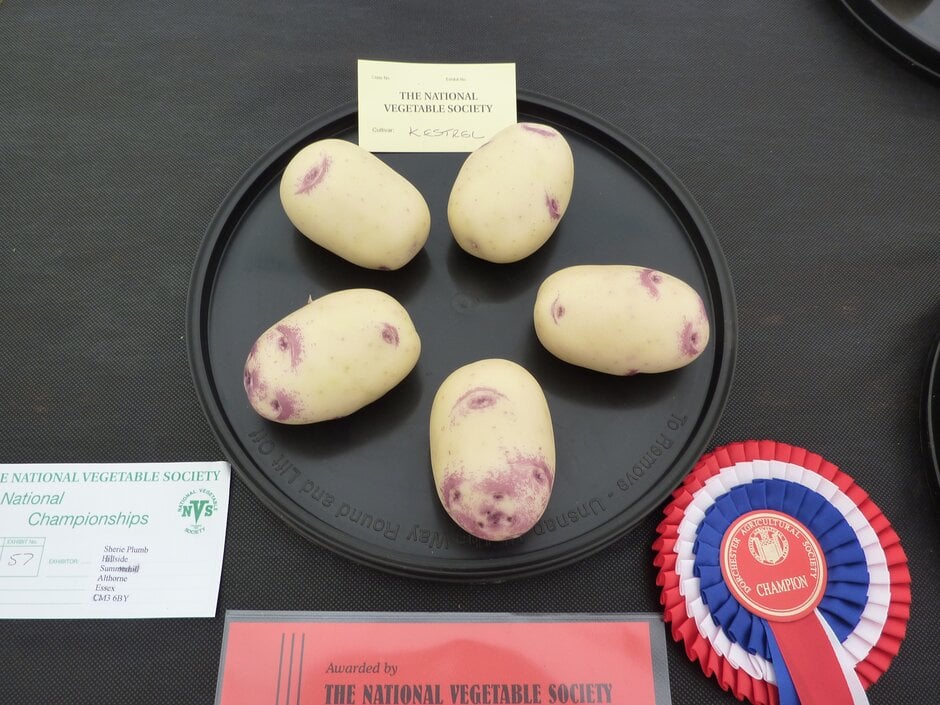Solanum tuberosum 'Kestrel'
potato 'Kestrel'
A fairly recent introduction to the market which is fast becoming a household favourite due to its delicious flavour. This second early potato has smooth skin with attractive with purple blue tints in places and is a great all rounder in the kitchen. It is a high yielding variety which grows well in heavy soils and tolerates dry conditions. Shows good resistance to Potato blackleg, as well as potato virus, slugs and bruising.

Buy this plant
Size
Ultimate height
0.5–1 metresTime to ultimate height
1 yearUltimate spread
0.1–0.5 metresGrowing conditions
Moisture
Moist but well–drainedpH
Acid, Alkaline, NeutralColour & scent
| Stem | Flower | Foliage | Fruit | |
| Spring | Purple White | Green | ||
|---|---|---|---|---|
| Summer | Purple White | Green | ||
| Autumn | ||||
| Winter |
Position
- Full shade
- Partial shade
Aspect
South–facing or West–facing
Exposure
Sheltered Hardiness
H2Botanical details
- Family
- Solanaceae
- Native to GB / Ireland
- No
- Foliage
- Deciduous
- Habit
- Bushy, Clump forming
- Potentially harmful
- Harmful if eaten, except potato crop. Wear gloves and other protective equipment when handling. Pets (dogs): Harmful if eaten, except potato crop - for further information and contact numbers regarding pets, see the HTA guide to potentially harmful plants
- Genus
Solanum can be annuals, perennials, evergreen or deciduous shrubs or twining climbers, with simple or pinnnately lobed leaves and star- or bowl-shaped, 5-lobed flowers with prominent stamens, followed by fleshy fruits
- Name status
Accepted
How to grow
Cultivation
Grow in an open, frost-free site with deep, fertile, moisture-retentive soil for high quality and heavy yields. Improve soil by adding organic matter, such as well-rotted manure, in the autumn. Draw earth up around the stems as they emerge, to exclude light and prevent the potatoes from becoming green. Water well in dry periods. Potatoes can also be grown in large containers or potato gro-bags. See potato cultivation for further advice.
Propagation
Propagate by chitting tubers or 'seed potatoes'. This is done by standing the tubers 'rose-end' up (the end with the most eyes) in egg boxes or trays in a cool, light place. After two to three weeks the shoots will begin to sprout. Plant out after frosts have passed, from about mid March to mid April.
Suggested planting locations and garden types
- Patio and container plants
- Cottage and informal garden
Pruning
No pruning required
Pests
Shows good resistance to slugs but may be susceptible to cutworms, wireworms, leaf and bud eelworm, Potato cyst nematodes
Diseases
May be susceptible to honey fungus (rarely). Shows good resistance to Potato blackleg and some Potato virus but may be susceptible to other Potato Virus, Potato scab, Potato blight, Potato rot and stem canker
Get involved
The Royal Horticultural Society is the UK’s leading gardening charity. We aim to enrich everyone’s life through plants, and make the UK a greener and more beautiful place.